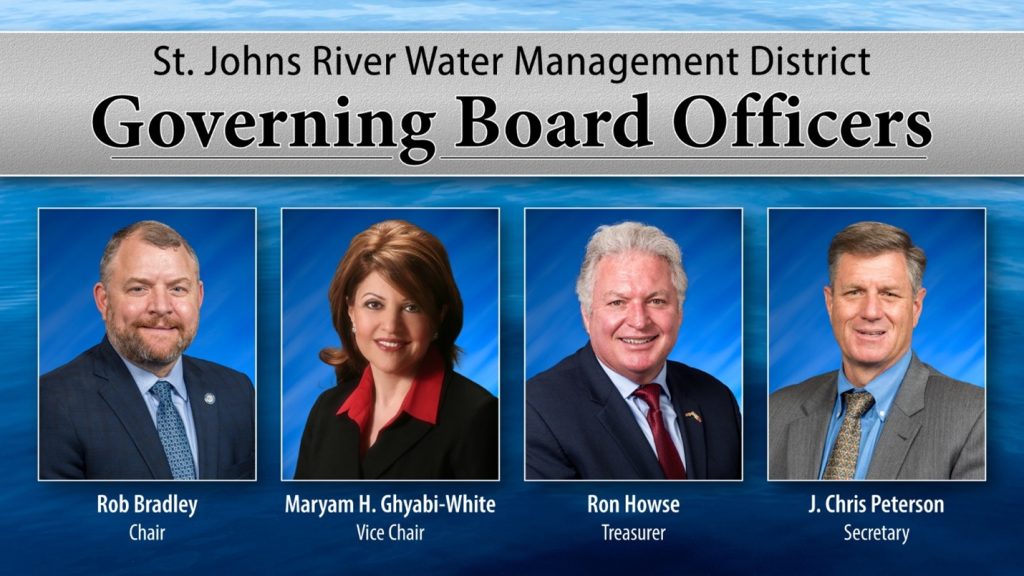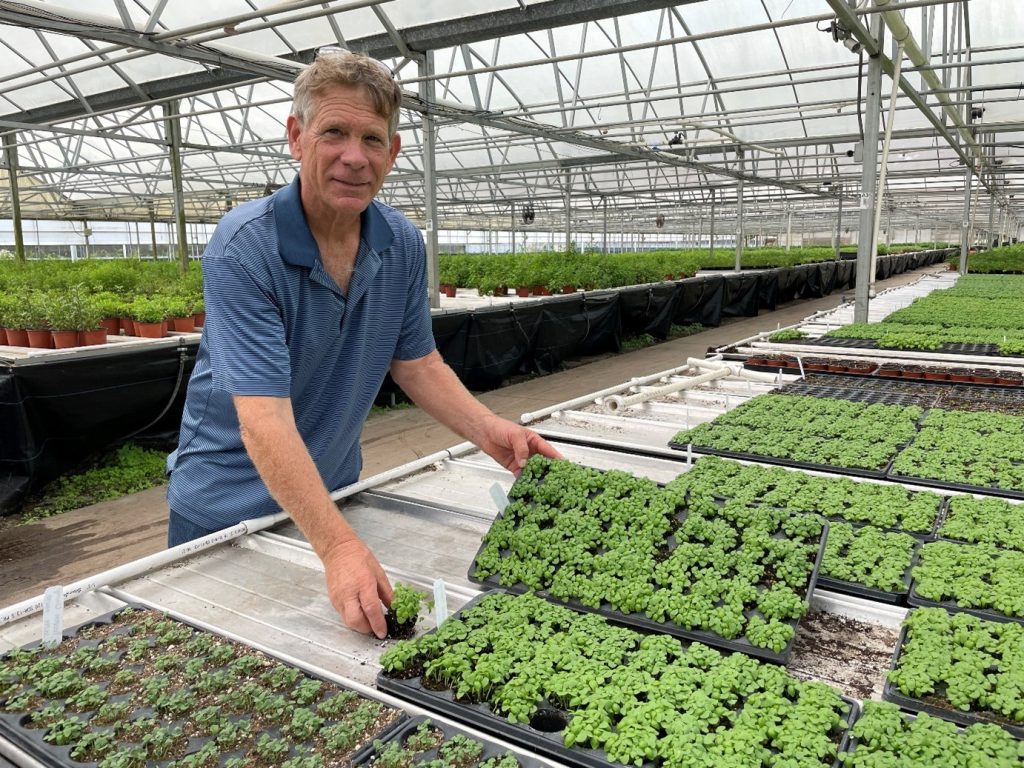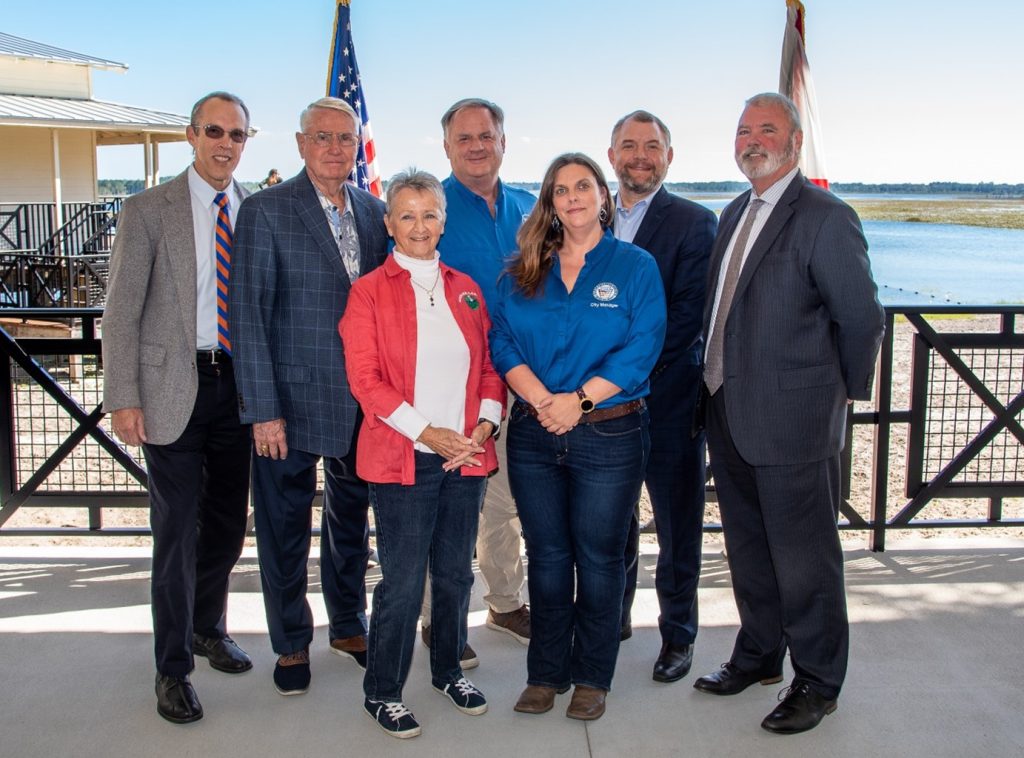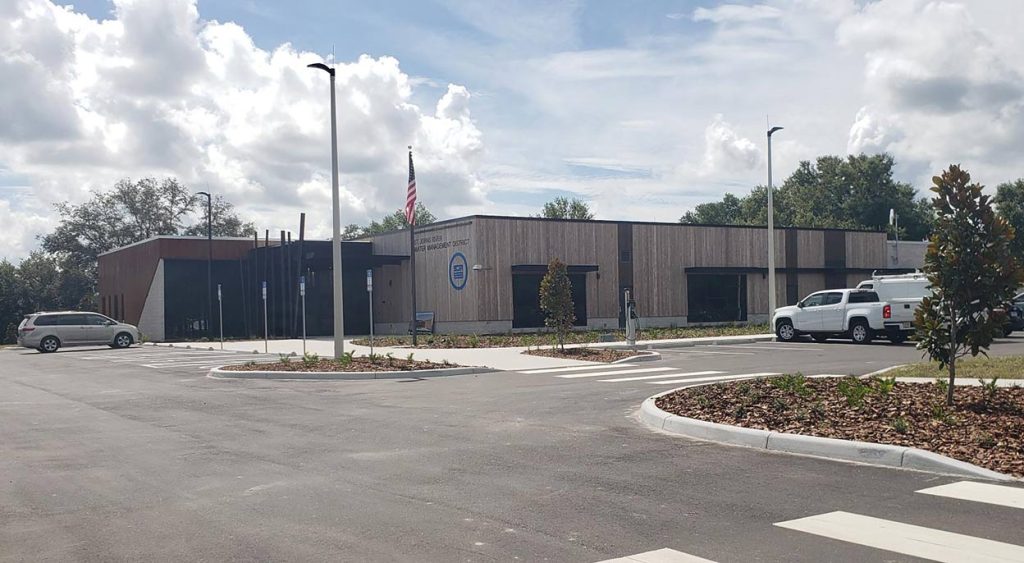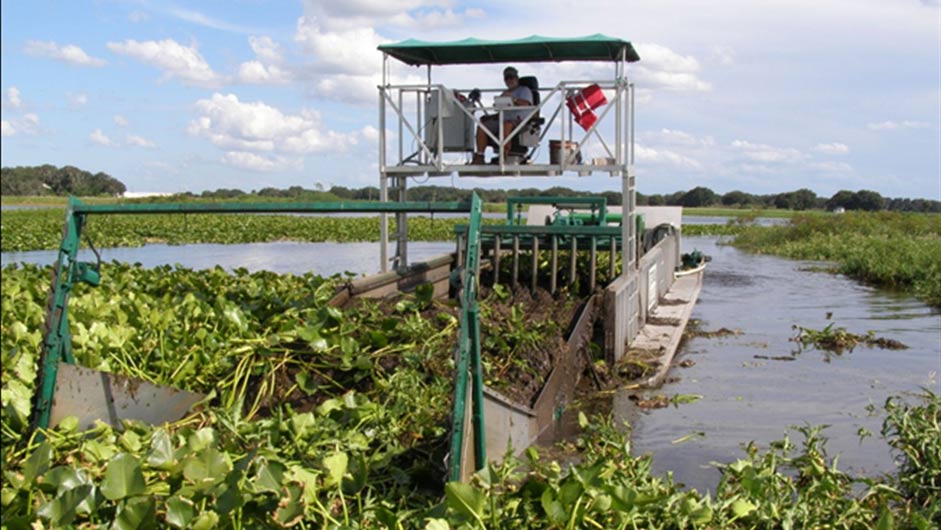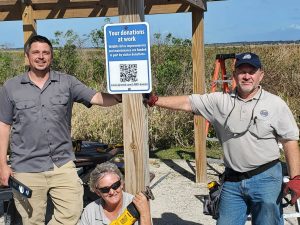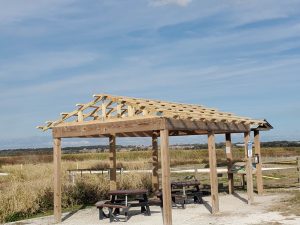Dec. 13, 2022
District Governing Board members received an update at their December meeting on the lasting effects of Hurricane Nicole, which moved through the region in early November. November rainfall averaged 4.24 inches, more than 2 inches above the average for the month.
Nov. 16, 2022
The District’s Lake Apopka North Shore’s Wildlife Drive reopened after high water levels from a hurricane in late September and a tropic storm in mid-November brought unusually high rainfall amounts. For the public’s safety, the drive had been closed while water receded and to allow for a downed powerline to be repaired.
Nov. 8, 2022
The District’s Governing Board re-elected Sen. Rob Bradley of Fleming Island to serve as its chair for a second year. The Board also elected Maryam Ghyabi-White of Ormond Beach to serve as vice chair; Ron Howse of Cocoa as treasurer; and J. Chris Peterson of Winter Park as secretary.
Nov. 8, 2022
The District’s Governing Board approved the execution of 13 contracts that will provide local growers with over $1.1 million in cost-share funds. Together, these projects will reduce water use by 73 million gallons per year and significantly reduce the amount of harmful nutrients that could potentially enter nearby water bodies. The District’s Agricultural Cost-Share Program was developed to assist farmers and growers who elect to execute projects that conserve water, reduce nutrient loading (amount of nutrients entering a water body), and result in more efficient farm management. Approved projects will receive up to 75 percent of cooperative funding, not to exceed $250,000 per applicant annually, toward the design, construction and implementation of technologies and strategies to improve water efficiencies and protect natural systems. In the photo: Bruce Cobb with MacGregor’s Greens in Mount Dora just completed a cost-share project to convert to a recirculating hydroponic system in his greenhouse that produces herbs for local residents and restaurants.
Nov. 8, 2022
The District’s Governing Board approved a new seal/logo for the District which prominently displays a cypress tree along the shoreline of the St. Johns River. This is the first update to the District’s logo in its 50-year history. The new design clearly connects the St. Johns River from which we take the agency’s name, the beautiful cypress trees that can be found all along the river and focuses on the water and natural resources that the District was established to protect.
Oct. 24, 2022
The District gathered with local and regional partners, residents, and other interested stakeholders to celebrate the launching of the Black Creek Water Resource Development project. The project, decades in the making, will increase recharge to the Upper Floridan aquifer in northeast Florida and improve water levels in lakes Brooklyn and Geneva. In photo: From left to right: Rick Hutton with Gainesville Regional Utility, District Governing Board Member General Douglas Burnett, Save Our Lakes Organization President Vivian Katz James, District Executive Director Mike Register, Keystone Heights City Manager Lynn Rutkowski, District Governing Board Chair Rob Bradley and Bradford County Manager Scott Kornegay.
Oct. 11, 2022
For the eighth consecutive year, the District Governing Board voted to approve $500,000 in funding for the Indian River Lagoon Council (IRL Council). The IRL Council was formed in 2015 and was established through an interlocal agreement between the St. Johns River Water Management District, South Florida Water Management District, the Florida Department of Environmental Protection (DEP) and the five counties that border the IRL system – Brevard, Indian River, Volusia, St. Lucie and Martin. The District supports IRL Council goals through both annual funding and cost-share projects with local governments and communities. Since 2015, the District has awarded $38 million for projects in Indian River Lagoon communities, leveraging a total of $81 million in public dollars when combined with local matching funds and/or state funds from DEP.
Sept. 27, 2022
While funding an unprecedented number of projects, the St. Johns River Water Management District’s Governing Board on Tuesday adopted its fiscal year 2022‒2023 budget and reduced its millage rate for a 10th consecutive year, keeping taxes low while providing significant funds for water resource protection and cost-share projects. The budget adopted by the board is approximately 10.9 percent higher than the FY 2021-22 Adopted Budget. The millage rate is about 9.8 percent less than the current year’s tax rate. In order to reduce the burden of taxpayers, the District has adopted the rolled-back millage rate since FY 2013–14.
Sept. 13, 2022
The District’s Governing Board approved the execution of seven contracts that will provide local growers with over $860,000 in cost-share funds. Together, these projects will reduce water use by 44 million gallons per year and significantly reduce the amount of harmful nutrients entering nearby water bodies, including the St. Johns River and Crescent Lake. The Tri-County Agricultural Area Water Management Partnership Cost-Share Program was developed to assist farmers and growers who choose to implement projects that conserve water, reduce nutrient loading (amount of nutrients entering a water body), and result in more efficient farm management in Flagler, Putnam and St. Johns counties.
Aug. 9, 2022
The District’s Governing Board approved two land purchases that will add an additional 101 acres to the Bayard Conservation Area in Clay County. The two properties are being sold to the District by Virginia Hall and J.P. Hall III and will help provide critical protection to an area that has routinely suffered from flooding. The increased conservation acreage will also provide additional shoreline stabilization of the St. Johns River. These purchases are part of a larger Bayard Point Land Acquisition Project that involves acquiring up to 266 acres of floodplain wetlands in the surrounding area for floodwater storage. The lands were acquired using a combination of District funds and grant monies received from the Florida Department of Environmental Protection’s Resilient Florida Program.
Aug. 9, 2022
the St. Johns River Water Management District and Volusia County gathered to celebrate the addition of 1,282 acres to the Palm Bluff Conservation Area. The properties, known as the 857-acre Schroeder property and the adjoining 425-acre Russell property, were purchased as part of a cost-share agreement with Volusia County’s Volusia Forever acquisition program and will be incorporated into the Palm Bluff Conservation Area. The acquisition will add more than 850 acres of the land that will be open to the public, including approximately three miles of public hiking trails, and offers additional protection for Deep Creek — a large tributary of the St. Johns River that connects Lake Harney with Lake Ashby.
July 25, 2022
The District’s newest service center opened in Apopka, replacing a previously rented facility in Maitland. The District broke ground on the new service center in February 2021, having rented in central Florida for 35 years. The service center is conveniently located near a major District restoration project – the Lake Apopka North Shore.
July 12, 2022
The Black Creek Water Resource Development Project moved forward, with the Governing Board approving a contract to begin the project’s first phase, which consists of constructing a water pump station. While the primary goal of the project is to increase recharge to the Upper Floridan aquifer, it will also improve water levels in lakes Brooklyn and Geneva.
June 14, 2022
The District’s Governing Board approved 10 contracts to provide local growers with more than $1 million in cost-share funds for projects to reduce water use and reduce the amount of nutrients going into local waterways, known as nutrient loading.
June 14, 2022
The District launched a project to mechanically harvest and remove mats of floating vegetation and the nutrients they contain from the waters of the Orange Creek Restoration Area as part of its work to improve water quality. The project focuses on about 33 acres of exotic and invasive plants. In addition to water quality improvements, the project improves native habitat conditions and improves access to other restoration areas.
May 10, 2022
The District’s Governing Board approved $20.5 million in funding for cost-share projects for fiscal year 2022–2023 as part of the Districtwide and Rural Economic Development Initiative (REDI) and Innovative cost-share programs. These projects all support one or more of the District’s core missions.
May 10, 2022
The District’s Governing Board approved two land purchases to expand a popular recreation and conservation area near Osteen. The properties are being purchased as part of a cost-sharing agreement with Volusia County’s Volusia Forever acquisition program and will be incorporated into the Palm Bluff Conservation Area. The acquired land contains an ecologically sensitive mix of forest and wetlands that are important for preservation, habitat protection, recreational use and groundwater recharge. The easement connects with the Volusia Conservation Corridor serves as a connected and protected habitat and passageway for wildlife. These purchases will expand the corridor to more than 40,000 acres.
April 12, 2022
Five agricultural projects were awarded a total of $552,000 in cost-share funds to conserve water and reduce nutrients that flow into area waterways. Projects include conversion from seepage to sub-irrigation drain tile, soil moisture probes and precision fertilizer application equipment with GPS. The five projects will reduce farms’ water use and are anticipated to reduce total nitrogen loading by 4,281 pounds per year and total phosphorus loading by 1,734 pounds per year.
March 8, 2022
Since October 2021, the District has plugged 62 free-flowing wells saving 10.4 million gallons of water a day. With about six months left in the fiscal year, the District was on track to plug more wells than any other year over the District’s 50-year history. In November 2021, the District’s Governing Board waived fees to plug eligible abandoned wells.
Feb. 14, 2022
The District’s Governing Board approved a regional water supply plan for the Central Springs/East Coast region of the District, including part or all of the following six counties: Volusia, Marion, Lake, Brevard, Indian River and Okeechobee. The plan is a collaborative process among the District, local governments, public supply utilities, environmental advocates and other interested stakeholders and is based on a planning horizon through 2040. It identifies water conservation potential and water supply and water resource development project options that can meet future water demand while sustaining water resources and related natural systems.
Feb. 9, 2022
Thanks to donations made to the Lake Apopka Wildlife Drive, the District and volunteers were able to provide a new resting place for both birds and humans, complete with picnic tables, covered shelter area and bird perches. The Lake Apopka North Shore, including the Wildlife Drive, is free to visit. However, the District receives donations from the public to support sanitation, recreational maintenance, security, and visitor brochures and maps.
Jan. 12, 2022
The District joined partners and interested stakeholders in celebrating the groundbreaking of a project that is integral to the success of the Volusia Prevention and Recovery Strategy. The strategy is a comprehensive strategy to protect Blue Spring and six Volusia County lakes from current and potential impacts of groundwater withdrawals, as part of the District’s minimum flows and levels program. Both the District and the Florida Department of Environmental Protection contributed funding to various phases of the project. This final phase consists of the construction of a surface water pump station on Lake Monroe and a transmission line that will allow the city of Deltona to pump and treat up to 4 million gallons a day of surface water. This water will be used to not only supplement the city’s reclaimed water system, but also allow them to provide any excess to other interconnected reclaimed water systems in the region and to recharge projects that would benefit Blue Spring.



